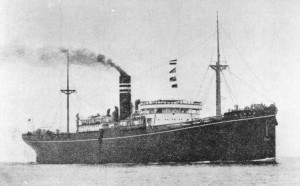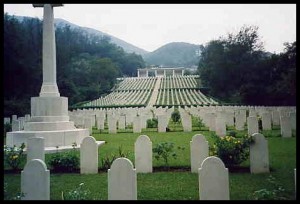Battery Sergeant Major (Warrant Officer Class II) 16130, Coastal Regt., Royal Artillery
Died Thursday, 1st October 1942 (Age 28)
Commemorated at: Sai Wan Memorial, China (Hong Kong)
Memorial Ref.: Column 1
William Arthur Barlow, born 1st Q 1914, was the son of Mrs P. Bromley (Nee Neale) and the stepson of Mr Bert Bromley of Jacksdale Street, Jacksdale. (Jacksdale Street was known by locals as ‘Stone Row’ and was demolished in 1968.)
William was a scholar at Jacksdale Council Schools, later taking up employment at Codnor Park Forge
William joined up at the age of 18 and Army life obviously suited him as he swiftly progressed through the ranks. He was an excellent sportsman and was a trained Army Boxing Instructor as well as being a sprinter of ‘no mean ability’ and also ‘an expert swimmer’.
An article in The Eastwood & Kimberley Advertiser dated 22nd January 1943, entitled ‘Jacksdale Officer Missing’ reports that William’s wife, Mrs Barlow of Old Windsor, Berks had been informed that her husband (who had previously been taken Prisoner of War at Hong Kong), was ‘posted as missing’ by the Japanese Authorities, following the sinking of the SS Lisbon Maru, a Japanese vessel, transporting prisoners of war to Japan. The article continued to say that ‘Mr Barlow was an expert swimmer and it is felt that there is every possibility that he is safe and sound’.
A further newspaper report in The Eastwood & Kimberley Advertiser, dated 29th October 1944, states that Mrs Barlow had received a communication from The War Office, Liverpool, that ‘after careful review of all of the available evidence, conclusion has been arrived at that all hope of the survival of her husband must be abandoned and that there can no longer be any alternative but to presume that he must have been lost when the ship “Lisbon Maru” was sunk’.
 SS Lisbon Maru (Courtesy Wikipedia - Public Domain)
SS Lisbon Maru (Courtesy Wikipedia - Public Domain)
The Commonwealth War Graves Commission records Warrant Officer Barlow’s date of death as Thursday 1st (or Friday 2nd) October 1942 and his age at time of death as 28.
Petty Officer Alf Hunt, a survivor on the Lisbon Maru explains the appalling conditions on board in his account ‘Story of Her Last Days’:
‘The Royal Artillery, under the command of Major Pitt, were ordered into the number three hold, abaft the bridge, as holds one and two were already packed full of soldiers of the Middlesex and Royal Scots Regiments. The men were being transported from Sham Shui Po Camp, Hong Kong, to Japan. Around 7 a.m. on the morning of the 1st October, the Lisbon Maru was torpedoed. The first three torpedoes missed but the fourth hit its target.
The prisoners remained in the holds which, by now, were in total darkness, packed in together, in filthy conditions, without enough room even to lie down. They remained like this all day, while the ship slowly started to list to the port side. During early evening a ship drew alongside to evacuate most of the 778 Japanese soldiers on board. A few remaining guards then wedged thick balks of timber over the hatches, as well as thick tarpaulins. In the early hours of 2nd October, the bulkhead was starting to give, with conditions in the hold becoming intolerable. Water could be heard swilling into a nearby compartment.
One brave man in Alf’s hold, who had a knife, forced it up through the tarpaulin and some of the men made a dash for their freedom. The Japanese Guards on deck opened fire, but were soon silenced.
By this time, the stern of the ship was under water and some men were already in the sea swimming for their lives. There were other ships nearby, obviously in enemy hands, as they were either trying to run down the survivors or shoot them while they swam.’
Alf was one of the few lucky ones, who did manage to swim the four miles to shore. Alf was cared for by the Chinese islanders of Sing Pan but within two days, the Japanese Navy had rounded up 970 survivors and they were swiftly shipped to Japan aboard the Shinsei Maru. 846 men had perished. It was learned later that 6 or 7 men actually managed to escape.
The survivors were sent to camps at Kokura and Hiroshima and subjected to appalling conditions and treatment, 200 dying only months later of diphtheria, pneumonia or dysentery.
For the families of the men who went aboard Lisbon Maru, no one will ever know which men drowned or which men survived to die later as the Japanese kept no records.
You can read Alf’s full account of the sinking on the Lisbon Maru website. The Lisbon Maru, a 7000 ton freighter, was armed as she carried Japanese troops but, in direct contravention of the Geneva Agreement, she bore no sign that she was carrying 1,816 PoWs. She was sunk by an American Submarine, the USS Grouper (SS-214).
In October 1946 the Japanese Master of the Lisbon Maru stood trial for his part in this war crime.
In 2001, almost sixty years on, ex-Prisoners of War, including survivors of the Lisbon Maru, met with ex-Japanese Servicemen, Japanese students, teachers and officials to share and help each other understand their experiences. The Japanese have shown overwhelming interest, compassion and remorse.
In addition, a reunion of survivors was held on board HMS Belfast on 2 October 2007 to mark the 65th anniversary of the escape. Six of the former prisoners attended, alongside many bereaved families of escapees and servicemen.













